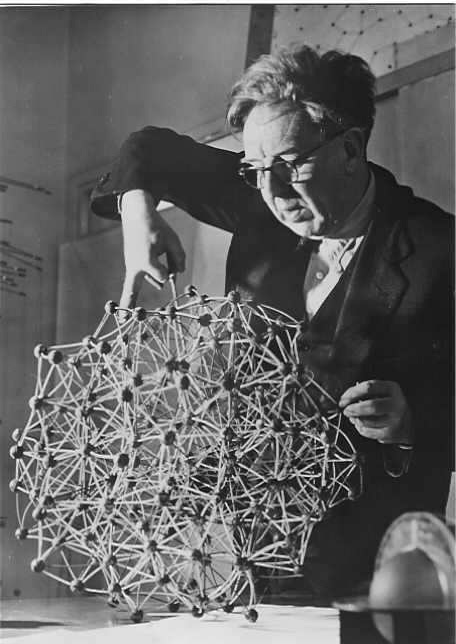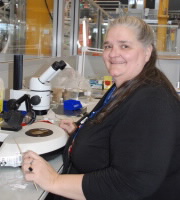J. D. Bernal and the structure of water
Can we understand the structure of a liquid? Dr Alison Edwards celebrates one of the pioneers of X-ray crystallography and how he thought about the structure of the most fundamental of liquids, water.
What does it look like?

J. D. Bernal and his model of a simple liquid. Image reproduced from 'Bernal and the structure of water' by J. L. Finney http://iopscience.iop.org/1742-6596/57/1/004/pdf/1742-6596_57_1_004.pdf
J. D. Bernal is shown building a model of a liquid, in which randomness was introduced by using a number of different sized connecting rods to separate the spheres which depict the atoms. This work stemmed from Bernal's insight that further work was required, due to his conviction that the proposed 1933 model was "too crystalline".
What is it and where did the structure come from?
The structure of water was determined by the application of Bernal's crystallographic understandings to a liquid system. This occurred in two bouts: the seminal work in 1933 with R. H. Fowler: 'A Theory of Water and Ionic Solution with Particular Reference to Hydrogen and Hydroxyl Ions' appears in the first volume of the Journal of Chemical Physics (pp. 515-548). It has citations numbering in the thousands and was highly influential in the formation of the thinking about the role played by water in biological systems. Later work in the sixties refined and improved the fit of his more randomised proposed model to available data. An excellent account of the original and later work can be accessed here.
On the 113th anniversary of the birth of J. D. Bernal, we should celebrate the application of careful thought to the solution of interesting problems!
Bernal was a thinker and scholar of such high renown that he was known to his friends as "Sage" – there are well-documented stories of the breadth and depth of his knowledge both within science and more broadly in the human condition. His scholarly output was prodigious and eminently readable and the biographies and articles about him are entertaining. The Biographical Memoir of the Fellows of the Royal Society (DOI: 10.1098/rsbm.1980.0002 is freely accessible at http://rsbm.royalsocietypublishing.org/content/26/16.full.pdf+html?sid=0d3d7824-c4ab-4e3c-8ec8-71330ee8a5ad ) and was written by one of his early students: Dorothy M.C. Hodgkin OM FRS it opens:
"John Desmond Bernal lived his life to the full. He liked to say that his biography ought to be written in four colours, on interleaved pages, to show his different activities, fitted together. Oral tradition differs as to the colours of the pages; black and white, certainly for science, red for politics, blue for arts, purple or yellow for his personal life."
In a science where "big data" is now a dominant feature it is instructive to remember that very significant insights into matter can be achieved by thinking clearly about the limited data which were available.






